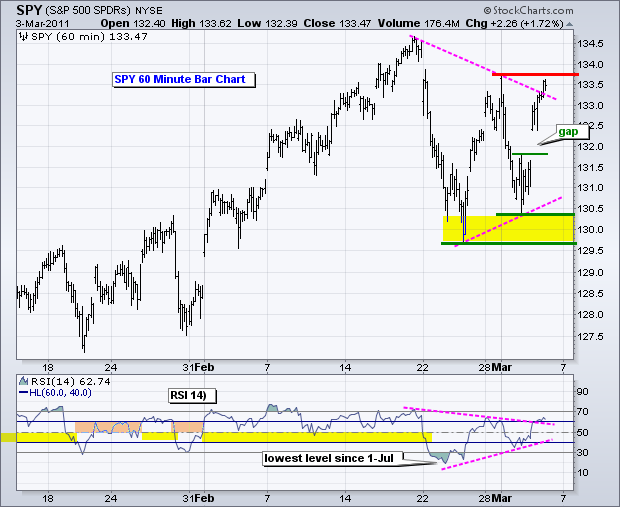The bulls are simply not to be denied. Despite a gap down and sharp decline last week as well as a bearish engulfing on Monday, stocks firmed above last week's low and SPY surged above 133 on Thursday. This is why I look at an array of indicators to assess the short-term trend. While short-term Nasdaq breadth turned bearish, NYSE breadth remained bullish. Short-term breadth turns bearish when the 10-day SMAs for Net Advances and Net Advancing Volume move below -100. Even though RSI broke below support at 40, SPY was entitled to a correction and never came close to key support, which WAS marked in the 127.5 area. While indicators can be helpful, I would trade all indicators for a simple bar chart because price action is the ultimate arbiter. With two bounces of the 130 area, I can now raise key short-term support to this level. In fact, this bounce looks impressive enough to qualify this zone as medium-term support as well.

Key Economic Reports/Events:
Thu - Mar 03 - 08:30 - Initial Claims
Thu - Mar 03 - 08:30 - Continuing Claims
Thu - Mar 03 - 10:00 - ISM Services
Fri - Mar 04 - 08:30 - Nonfarm Payrolls
Fri - Mar 04 - 10:00 - Factory Orders
Charts of Interest: Tuesday and Thursday in separate post.
-----------------------------------------------------------------------------
This commentary and charts-of-interest are designed to stimulate thinking. This analysis is not a recommendation to buy, sell, hold or sell short any security (stock ETF or otherwise). We all need to think for ourselves when it comes to trading our own accounts. First, it is the only way to really learn. Second, we are the only ones responsible for our decisions. Think of these charts as food for further analysis. Before making a trade, it is important to have a plan. Plan the trade and trade the plan. Among other things, this includes setting a trigger level, a target area and a stop-loss level. It is also important to plan for three possible price movements: advance, decline or sideways. Have a plan for all three scenarios BEFORE making the trade. Consider possible holding times. And finally, look at overall market conditions and sector/industry performance.







